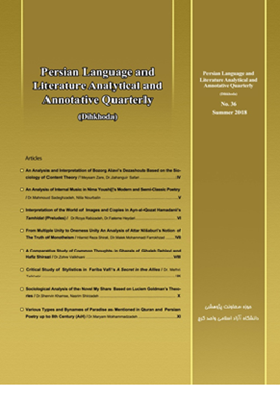From Multiple Unity to Oneness Unity An Analysis of Attār Nīšābūrī’s Notion of The Truth of Monotheism
Subject Areas : Persian language and literature textsHamidreza Shirali 1 , Malek Mohammad Farokhzad 2 *
1 - PhD Candidate of Persian Language and Literature, Islamic Azad University, Saveh Branch
2 - Assistant Professor of Persian Language and Literature, Islamic Azad University, Saveh Branch
Keywords: توحید, عطار نیشابوری, monotheism, وحدتِ احدی, وحدتِ عددی, multiple unity, oneness unity, Attār Nīšābūrī,
Abstract :
The first consensually accepted theological, philosophical, and mystical principle among all Muslims and followers of Ibrahim’s religion is monotheism, and the belief in this unaltered principle, is undoubtedly the product of the truth of monotheism that governs all the existence. However, it should not be ignored that ultimate knowledge about this solid and integrated principle is hardly achievable and rarely attainable, and according to the beliefs and sayings of all distinguished mystics of Islamic countries the perfect manifestation and the most justified form of monotheism is merely in the authority of the Perfect Man ever, who is the Excellency of the Master of Prophets, Mohammad (PBUH). On the belief of Islamic thinkers the knowledge about the boundaries between oneness unity and multiple unity is out of the toleration and understanding of all human beings; and what the knowledgeable masters believe as the “annihilation in God”, is indeed drowning in unbounded ocean of oneness unity; the unity that its only God will not let a twin whatsoever. The present research is undertaking the study of the monotheism in Farīd-al-dīn Mohammad Attār Nīšābūrī’s works.
_||_

